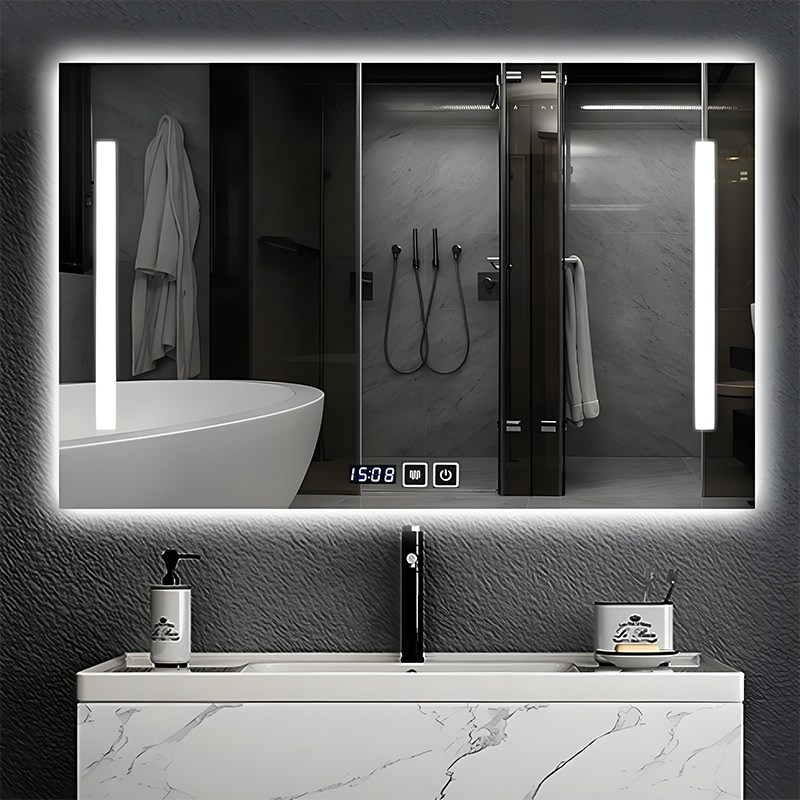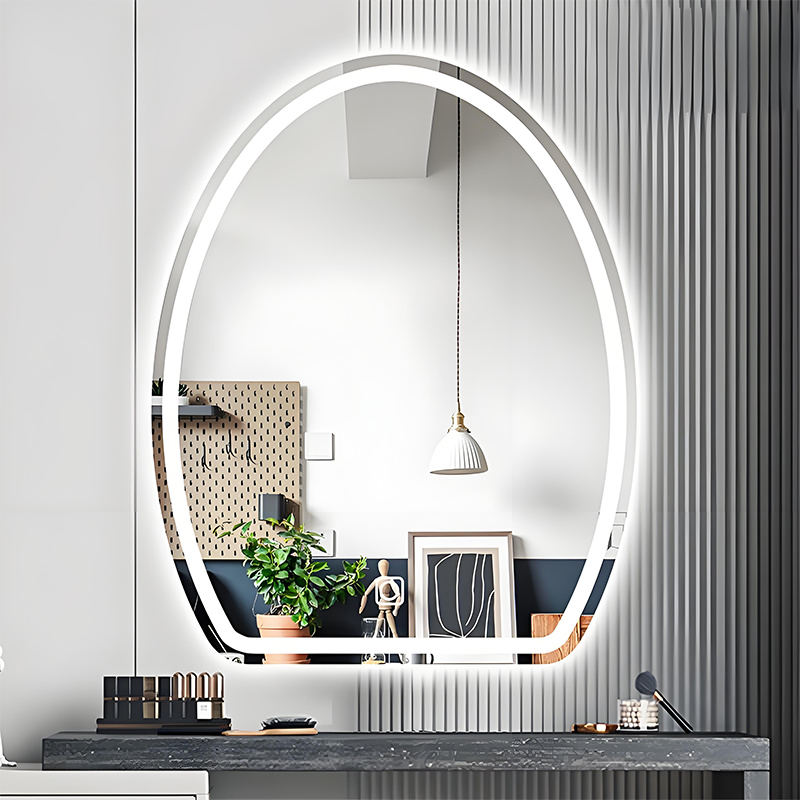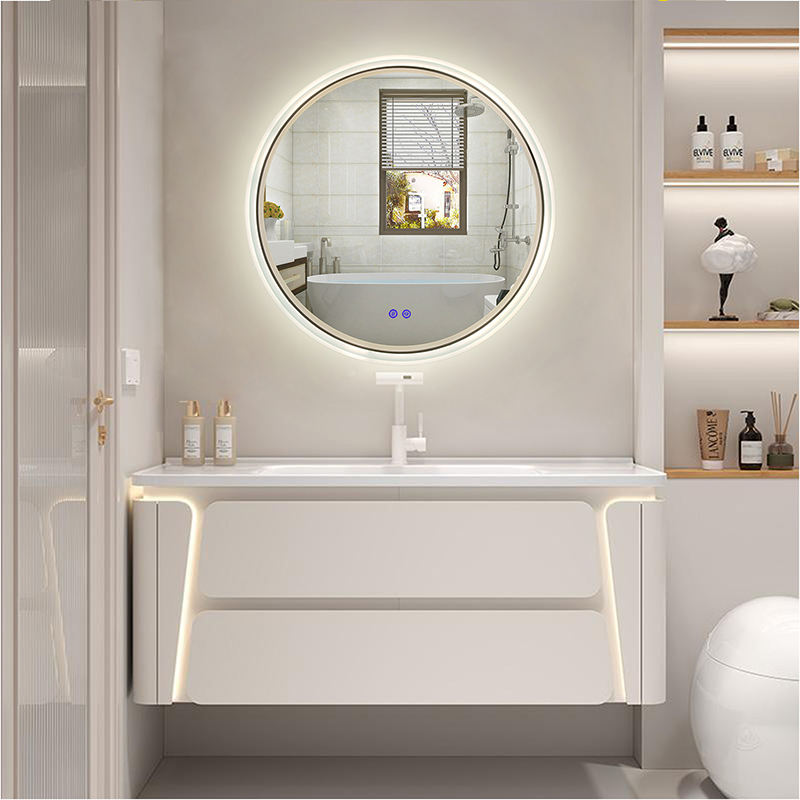In the morning, when you wash up in the bathroom, the mirror reflects your sleepy eyes, your fingertips touch the switch inadvertently, the soft light turns on, the mirror door slides open, the built-in socket is silently charging the electric toothbrush, and the skin care products and razors on the inside of the door are neatly arranged - this is not a future picture, but the daily experience given by the current smart mirror cabinet. According to the 2024 Global Bathroom Market Report, the sales volume of multi-functional mirror cabinets has jumped at an average annual growth rate of 17% in the past five years, becoming the first choice for urban family bathroom upgrades. This design revolution in a small space is quietly reshaping our lifestyle.
Mirror cabinets have long surpassed the simple mirror function and have become a composite home product that integrates storage, lighting, technology and aesthetics. Its core value lies in the ultimate use of vertical space: in an average washbasin area of only 0.5 square meters, a mirror cabinet with a depth of 15-20 cm can create storage space equivalent to a medium-sized drawer. Case studies from the German Institute for Space Planning show that the rational use of mirror cabinets can reduce clutter on bathroom countertops by 70% and increase the sense of visual space expansion by more than 40%.
1. In-depth analysis of mirror cabinets: evolution of materials, structure and function
1.1 Core structure and material evolution
Mirror technology: From traditional float glass to copper-free silver mirror technology, modern mirrors use vacuum magnetron sputtering coating, with a reflectivity of up to 92% and corrosion resistance. High-end products also add explosion-proof film, which makes the fragments stick together when broken, greatly improving safety.
Cabinet material: Aluminum alloy frames have become the mainstream because of their lightness and corrosion resistance, and internal layers are mostly made of moisture-proof ABS engineering plastics or 304 stainless steel. Frontier brands have introduced aviation-grade carbon fiber composite materials, which increase strength by 3 times and reduce weight by 40%.
Backboard technology: The moisture-proof backboard uses a honeycomb structure aluminum plate to isolate moisture and enhance load-bearing capacity. Some products are embedded with diatom mud coatings, and the humidity fluctuation in the cabinet can be adjusted within the range of ±5%.
1.2 Engineering aesthetics of opening method
Hinged door hinge: German Hettich hydraulic hinge can open and close 150,000 times without attenuation, supports 110-degree wide-angle opening, and the cabinet door can hover at any position.
Sliding door system: The track has built-in self-lubricating ceramic ball bearings, and the push-pull force is only 1.2N. The three-link design has an opening width of 75% of the cabinet body, which is suitable for narrow spaces.
Electric lifting: Silent motor drive (noise <35dB), rebound protection when encountering resistance, and integrated gesture sensing module to achieve non-contact operation.
1.3 Modular Revolution of Storage Systems
Adjustable shelves: 1cm spacing can be precisely adjusted through snap-on columns, with a load-bearing capacity of 5kg/layer
Rotating accessories: 360-degree rotating shelves increase the efficiency of picking and placing by 60%, and the patented damping design prevents high-speed rotation
Magnetic partitions: The cabinet door has a built-in strong magnet layer, which is compatible with various magnetic storage boxes, and the space utilization rate is increased by 45%.
2. Smart mirror cabinet: redefining bathroom experience
The core value of the smart mirror cabinet lies in scenario-based services: the morning mode automatically turns on 6500K cool white light to help you wake up; the 3000K warm yellow light is turned on at night to avoid glare; the humidity sensor triggers the anti-fog module during bathing; and it can even analyze skin condition through AI to recommend care plans.
2.1 Disruptive Innovation of Interactive Interface
Capacitive touch: AG anti-glare glass + nano silver wire technology, touch accuracy reaches 99% in humid environment
Voice interaction: built-in dual microphone array, voice wake-up recognition rate within 5 meters 92%, support multi-language commands
Screenless display technology: laser projection forms a virtual interface on the mirror surface, which disappears automatically 3 seconds after operation to keep the mirror intact
2.2 In-depth expansion of health management functions
Phototherapy module: integrated 450nm blue light (inhibits acne bacteria) and 633nm red light (promotes collagen regeneration). Clinically tested, 8 minutes of daily use can improve skin elasticity by 18% after 4 weeks
Body scale integration: cabinet foot pressure sensor with an accuracy of 50g, APP automatically generates body fat change curve
Environmental monitoring: PM2.5/VOC/TVOC three-in-one sensor, automatic fresh air prompt when exceeding the standard
2.3 Smart Hub of Ecological Interconnection
Energy management: Connect to the home photovoltaic system and give priority to using clean energy to charge the device
Sanitary ware linkage: automatically raise the smart toilet lid when the user approaches, and pre-adjust the water temperature to the preferred temperature
Data center: analyze water/electricity usage habits, generate energy-saving reports and optimize equipment operation strategies
3 Anti-fog mirror cabinet: Overcoming the century-old problem of bathroom.
The pain point of traditional mirrors becoming blurred when exposed to steam has been completely eliminated by anti-fog mirror cabinet technology. Its core lies in the fusion application of thermodynamics and material science:
3.1 Analysis of active anti-fog technology
Electric heating film solution: Graphene conductive film coverage reaches 95%, and the temperature rises to 45°C in 30 seconds (only 15W in energy-saving mode)
Hot air circulation: The micro-turbofan draws air from the top of the cabinet, and blows it out evenly from the micropores on the mirror after PTC heating
Semiconductor dehumidification: The Peltier effect cools the back of the mirror to below the dew point, and the condensed water is introduced into the drainage groove
3.2 Passive defense of nano-coatings
Hydrophilic coating: Titanium dioxide nanolayer forms a smooth water film when in contact with water vapor, and the light transmittance remains at 92%
Superhydrophobic technology: Fluorosilicone polymer constructs a micro-nano structure, with a contact angle of >150°, and water droplets roll off instantly
Self-cleaning properties: The photocatalytic coating decomposes organic matter under LED irradiation, and the cleaning cycle is extended by 5 times
3.3 Scene Adaptation Algorithm
Linked bathroom heater: automatically enhance anti-fog power when humidity exceeds 65%
Human body sensing: enter sleep mode when no one is around, energy saving rate reaches 80%
Learning memory: record peak bathing time at home, start preheating 10 minutes in advance
4. Scientific Guide to Buying Mirror Cabinets
4.1 Golden Rule of Spatial Adaptation
Width formula: mirror cabinet width = (basin width - 20cm) ± 5cm (e.g. 80cm basin, choose 60-70cm mirror cabinet)
Installation height: cabinet bottom 35-40cm from countertop (suitable for Asian height), mirror centerline 15cm below eye level
Depth selection: standard 15cm (suitable for toothpaste/skin care products); upgraded 20cm (accommodate hair dryer/beauty instrument)
4.2 Function Combination Decision Tree
Single apartment: basic storage + anti-fog (budget 800-1500 yuan)
Family of three: smart lighting + USB charging (budget 2000-3500 yuan)
Quality upgrade: health monitoring + ecological interconnection (budget more than 4000 yuan)
4.3 Key points for installation acceptance
Load-bearing test: 10kg pressure is applied to the center of the shelf for 24 hours, and the deformation is <2mm
Sealing test: The gap between the cabinet and the wall is <1mm, and the anti-mildew glue is filled evenly without breakpoints
Circuit safety: The operating current of the leakage protection device is ≤10mA, and the grounding resistance is <0.1Ω
5. The future of mirror cabinets
TOTO Laboratory in Japan is developing a "mirror cabinet eco-farm": using mirror cabinet lights to cultivate edible microalgae, with daily output meeting 30% of the protein needs of adults. The "emotional mirror" project of the MIT Media Lab provides mental health warnings through micro-expression analysis. More cutting-edge is the AR beauty mirror cabinet, which can project different makeup effects and automatically push products in the cosmetics cold storage.
When the mirror surface changes from passive reflection to active interaction, the mirror cabinet is becoming a smart node in the living space. It is not only a storage tool, but also a health butler, an environmental hub, and a data portal. Futurist Kevin Kelly pointed out: "The most disruptive technology is often born at the intersection of different fields." In the once neglected space of bathroom, the mirror cabinet is integrating material engineering, the Internet of Things, and biotechnology to achieve a leap.
The essence of choosing a mirror cabinet is to choose an efficient, elegant, and intelligent lifestyle. It turns the twice-daily washing ritual into a life enjoyment enabled by technology. When you start a new day in front of the mirror, the clear world reflected is the epitome of the evolution of modern home intelligence.




